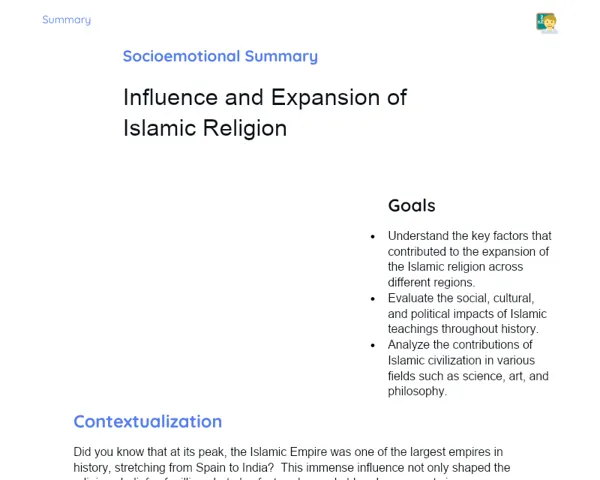Socioemotional Summary Conclusion
Goals
1. 🌟 Understand the features of early civilizations in Mesopotamia.
2. ✍️ Acknowledge the significance of cuneiform writing.
3. 👩🌾 Learn how agriculture spurred the growth of Mesopotamian cities.
4. 📜 Discover the Code of Hammurabi and its relevance to contemporary society.
5. 🏛️ Explore the political and religious structure of Mesopotamia.
Contextualization
Prepare yourself for an incredible journey into the past! 🌍 Mesopotamia, nestled between the Tigris and Euphrates rivers, is famously known as the cradle of civilization. Imagine existing in an era when the first cities sprang to life, writing began to form, and groundbreaking technological advancements were unfolding. Yes, today's adventure takes us to that fascinating time, where we will see how these ancient civilizations laid the groundwork for the world we live in today. Ready to embark on this journey? Let's set off! 🚀
Exercising Your Knowledge
Agriculture
Agriculture stood as one of the core pillars of Mesopotamian civilization. With the fertile soil enriched by silt from the Tigris and Euphrates rivers, the Mesopotamians devised sophisticated irrigation techniques that allowed for large-scale farming. This innovation was crucial for the sustenance of urban centres and enabled job specialization, meaning not everyone had to be engaged in food production.
-
🌾 Fertile Soils: The nourishing qualities of Mesopotamian soils originated from the Tigris and Euphrates rivers, which deposited silt after seasonal floods, making the land perfect for farming.
-
🚜 Irrigation Techniques: The Mesopotamians constructed intricate irrigation channels that ensured efficient water distribution to crops, leading to plentiful harvests.
-
👩🌾 Job Specialization: With agricultural stability in place, other sectors such as craftsmanship, trade, and administration flourished, resulting in a more organized and intricate society.
Cuneiform Writing
Cuneiform writing, pioneered by the Sumerians, is recognized as one of the earliest writing systems known to mankind. Using styluses to create impressions on clay tablets, it documented everything from trade dealings to legal codes and epic tales. This innovative writing system not only improved communication but also fortified the social and political frameworks of Mesopotamia.
-
✍️ Origin and Development: Emerging around 3500 B.C., cuneiform evolved from basic pictograms into a rich lexicon of symbols representing sounds and meanings.
-
🗂️ Documentation: Cuneiform facilitated writing on clay tablets, leading to the preservation of laws, trading records, myths, and significant historical events.
-
🔗 Social Impact: The advent of writing fostered enhanced administrative oversight and legal governance, promoting social and economic unity.
Code of Hammurabi
The Code of Hammurabi is known as one of the oldest written legal codes. Instituted by King Hammurabi of Babylon, this code outlined distinct rules and penalties for various offenses. It mirrored an organized society structured hierarchically, where laws were pivotal for maintaining order and justice.
-
⚖️ Written Laws: The Code of Hammurabi comprised 282 laws addressing numerous aspects of everyday life, including trade, property rights, marriage, and criminal penalties.
-
🏛️ Justice and Hierarchy: The application of these laws was tiered according to an individual's social standing, embodying the existing hierarchy within Mesopotamian society.
-
📜 Preservation and Influence: Carved onto stone steles and disseminated throughout the realm, the Code influenced successive legal systems, leaving an enduring mark in the annals of law.
Key Terms
-
Mesopotamia: A historical region situated between the Tigris and Euphrates rivers, referred to as the cradle of civilization.
-
Cuneiform Writing: An ancient writing system devised by the Sumerians, characterized by markings on clay tablets.
-
Code of Hammurabi: One of the earliest codified legal frameworks, instituted by King Hammurabi of Babylon.
-
City-States: Autonomous political units comprising a central city and its adjacent territories.
-
Ziggurat: A tiered pyramid-like structure that served as a temple in Mesopotamian cities.
For Reflection
-
🤔 How did the advent of cuneiform writing reshape communication and social structures in Mesopotamia?
-
💭 In what ways can the irrigation methods employed in Mesopotamia be regarded as key examples of technological advancement and community teamwork? How did these innovations influence the day-to-day lives of the people?
-
🧠 The Code of Hammurabi laid out clear laws and repercussions for various crimes. How can these regulations be interpreted as a mirror of the values and necessities of Mesopotamian society? Why is it important to have established rules in any society?
Important Conclusions
-
🌾 The agricultural practices in Mesopotamia were crucial for the rise of the first urban centers, bolstered by innovative irrigation systems.
-
✍️ Cuneiform writing changed communication and administration, making it possible to maintain comprehensive records of laws, trade, and mythology.
-
📜 The Code of Hammurabi established a clear and structured legal framework, reflecting the organization and values of Mesopotamian society.
Impacts on Society
The legacy of Mesopotamia continues to influence our lives in remarkable ways. For instance, cuneiform writing laid the groundwork for all modern writing systems we utilize today. Imagine life without the ability to jot down notes, create grocery lists, or learn from books! Moreover, the irrigation practices developed in Mesopotamia are foundational to contemporary farming methods, ensuring we have food on our plates daily.
On an emotional level, the Code of Hammurabi underlines the necessity of having well-defined rules for peaceful coexistence within society. It prompts us to think about how laws and norms help establish order and justice in our everyday interactions, from waiting our turn in queues to adhering to traffic regulations. Understanding the importance of these structures allows us to appreciate our present lives and deepens our comprehension of justice and collaboration.
Dealing with Emotions
To navigate your emotions while exploring Mesopotamia, I suggest an exercise based on the RULER method. Begin by taking a few minutes to recognize how you felt when uncovering Mesopotamian laws and social structures. Then, understand the reasons behind those emotions. For instance, learning about the Code of Hammurabi might spark feelings of surprise or curiosity. Name these emotions accurately - was it awe, interest, or perhaps frustration about unanswered questions? Next, express these emotions healthily, whether through journaling or chatting with a friend or family member. Finally, regulate these feelings by contemplating how you can implement the lessons absorbed in your daily life, such as appreciating rules and teamwork.
Study Tips
-
📝 Maintain a study journal! Document your insights and reflections on each area you study. This practice reinforces content retention and enhances your understanding of emotional responses.
-
🎨 Craft mind maps or illustrations of Mesopotamian cities. Visualizing information creatively can enrich your learning experience.
-
📚 Seek out documentaries or videos about Mesopotamia. Witnessing these civilizations in action can heighten your interest and comprehension of the subject.


